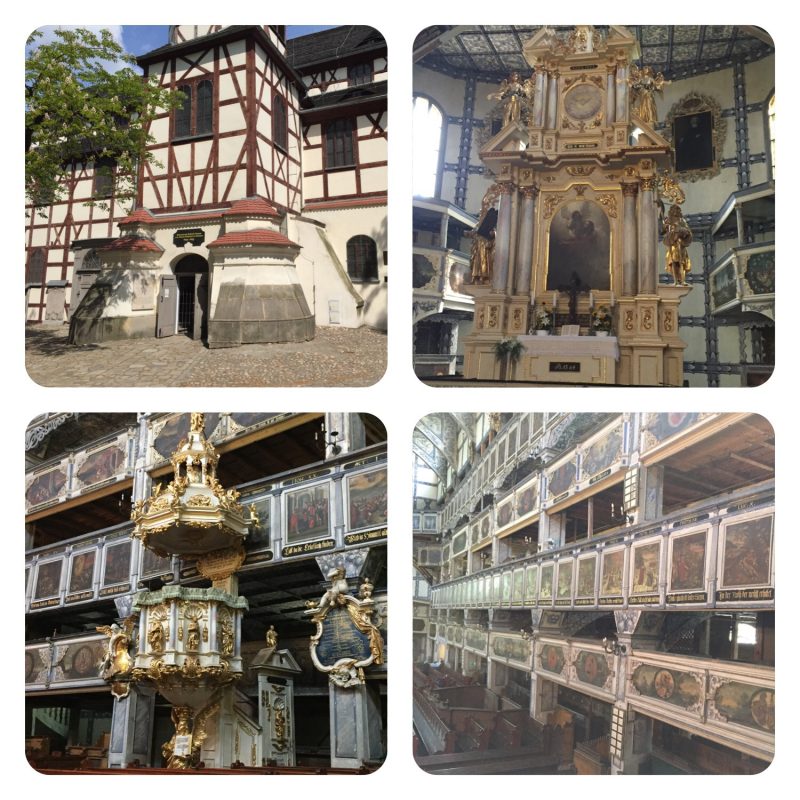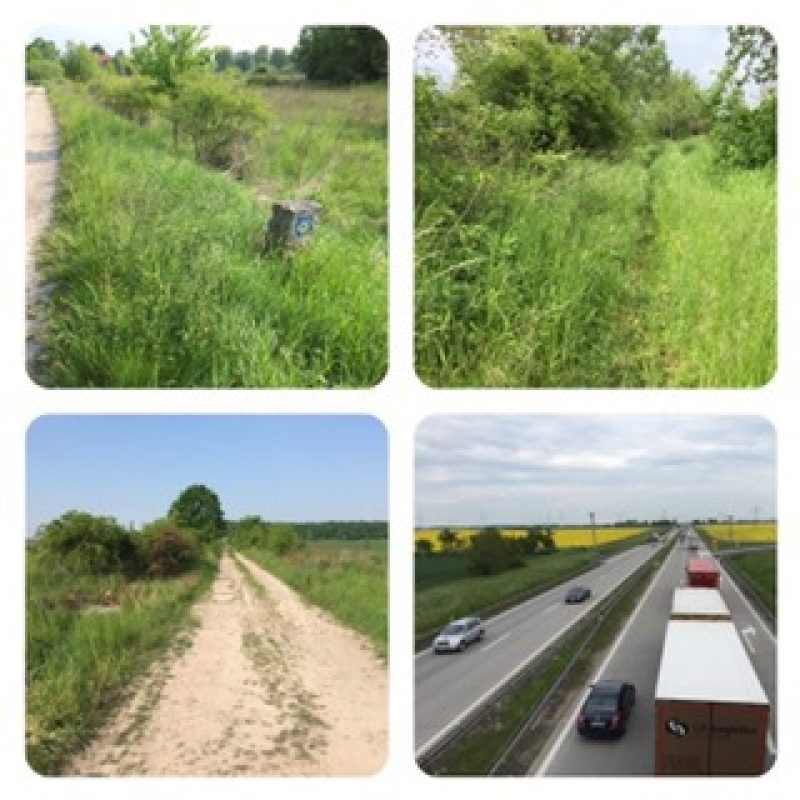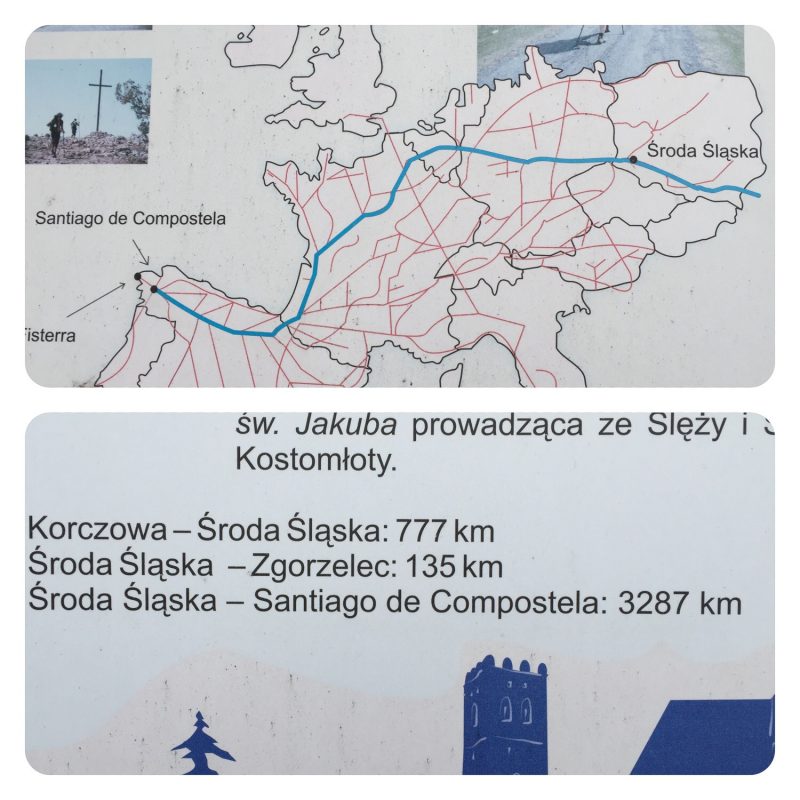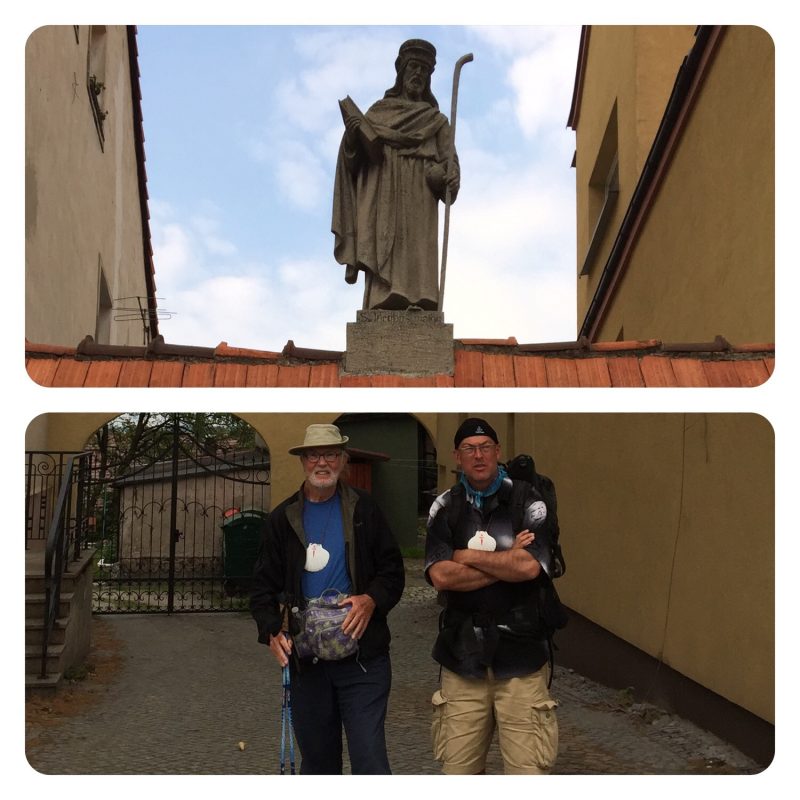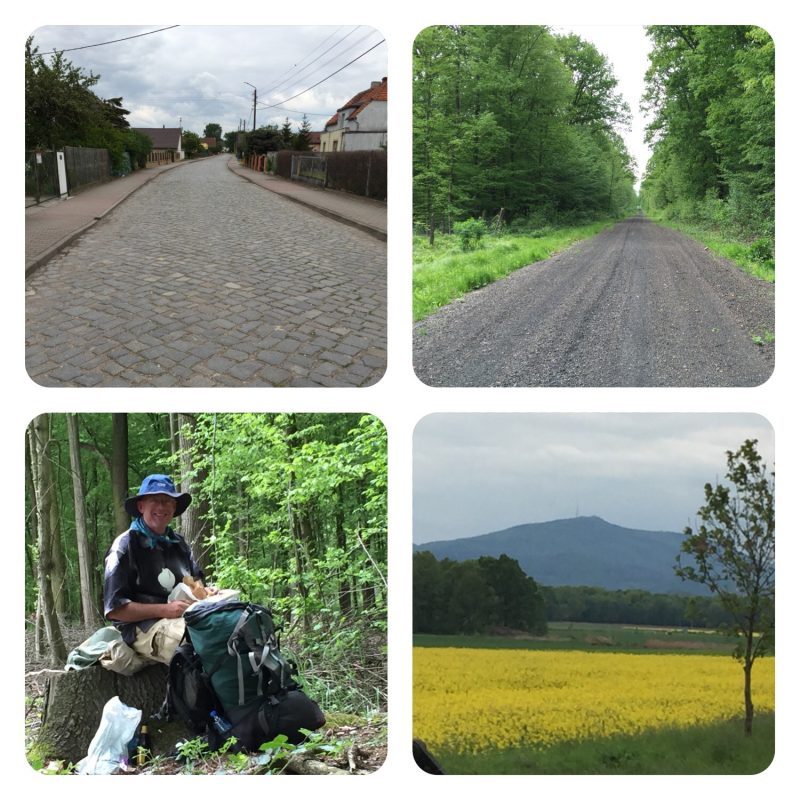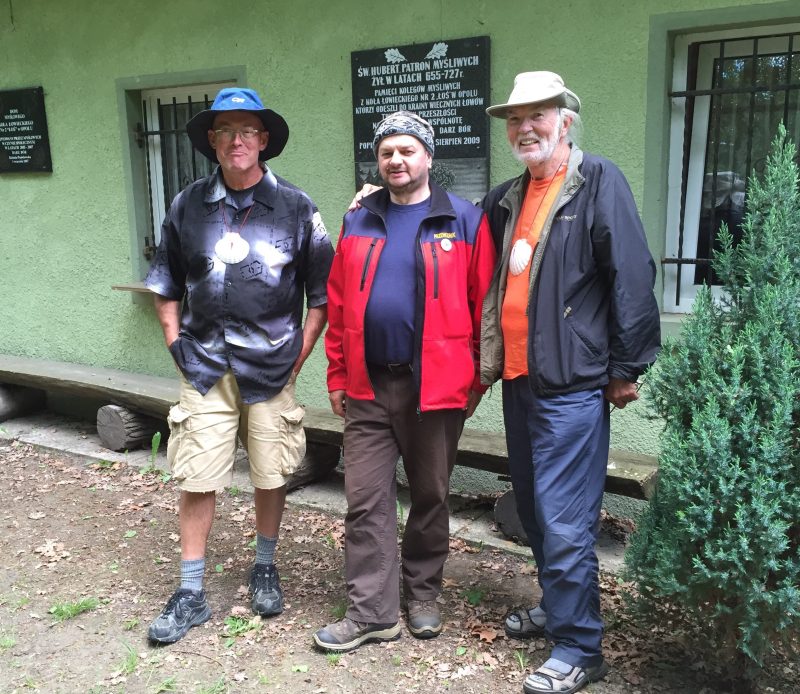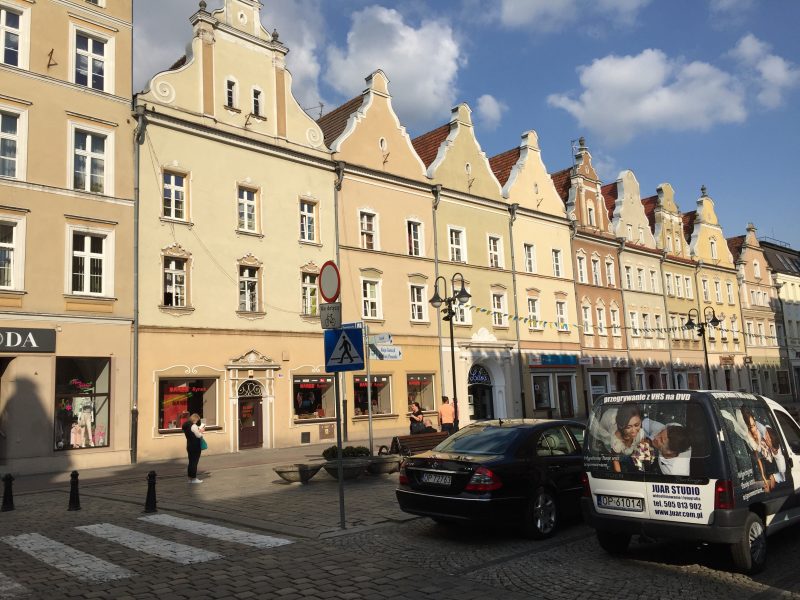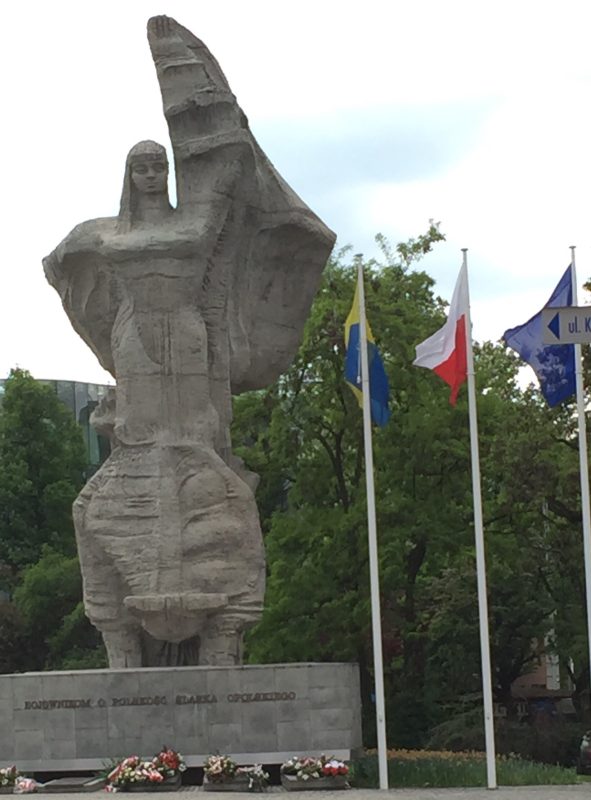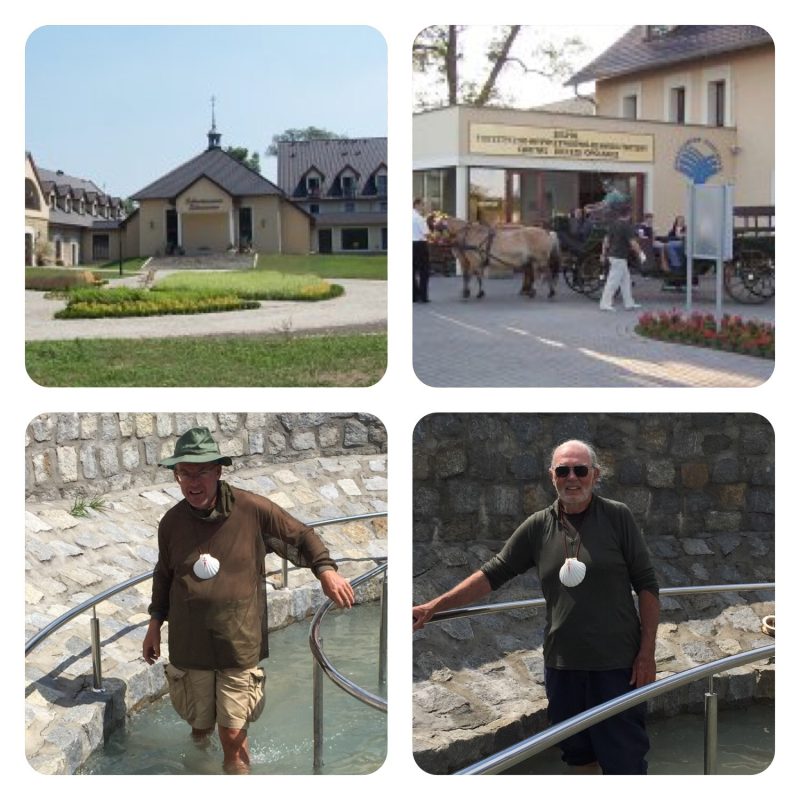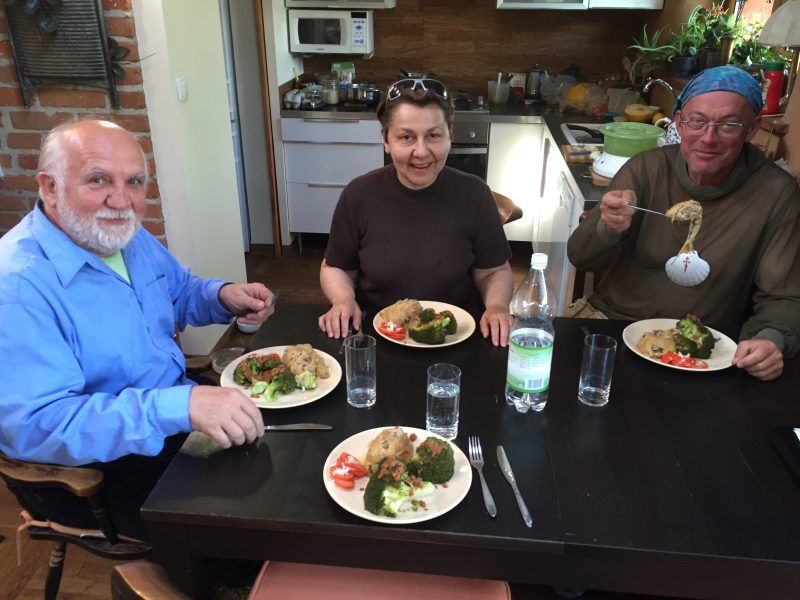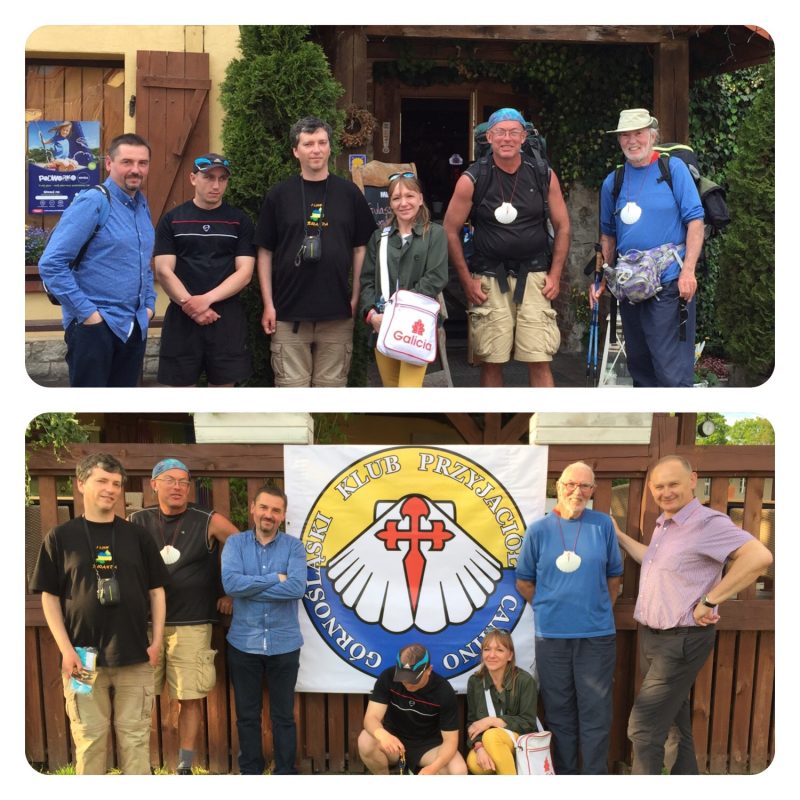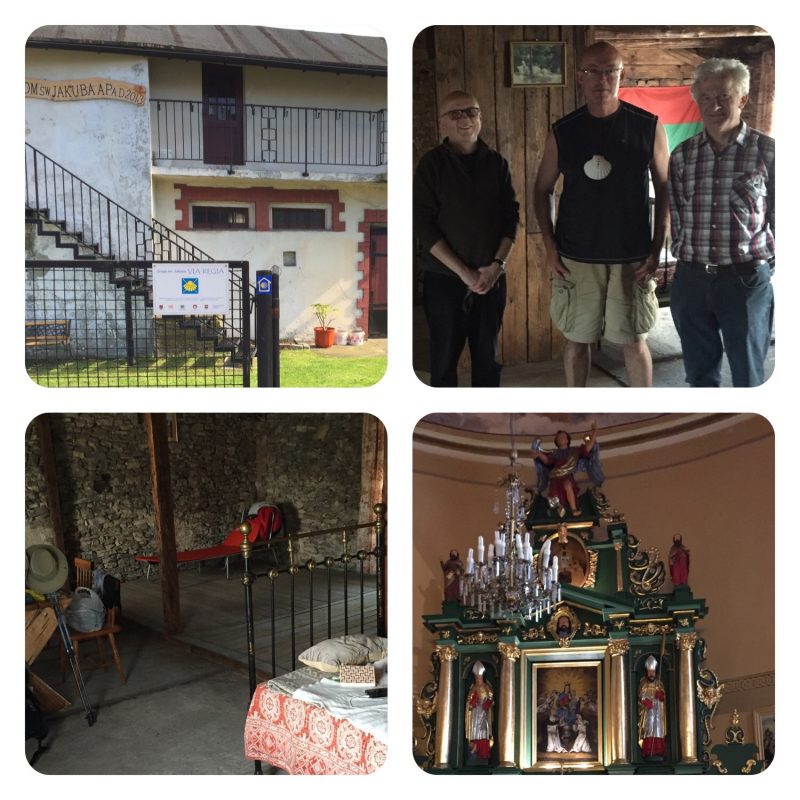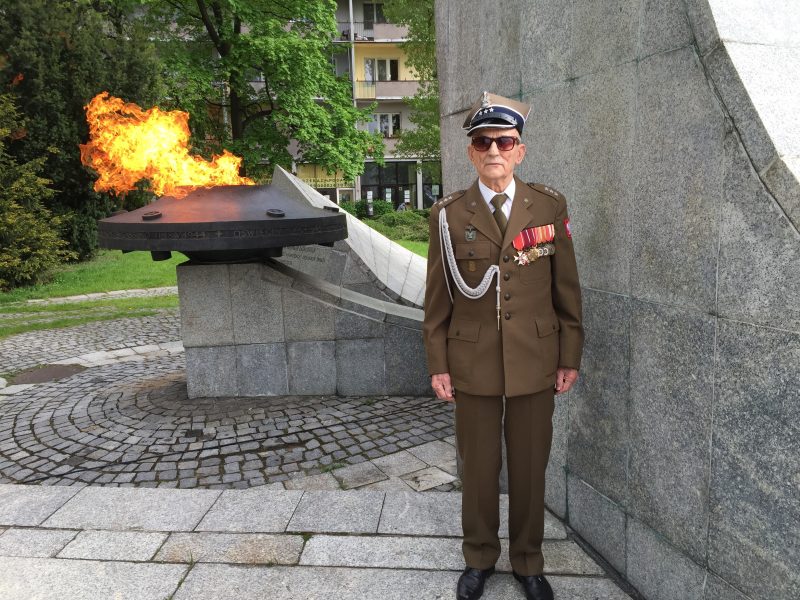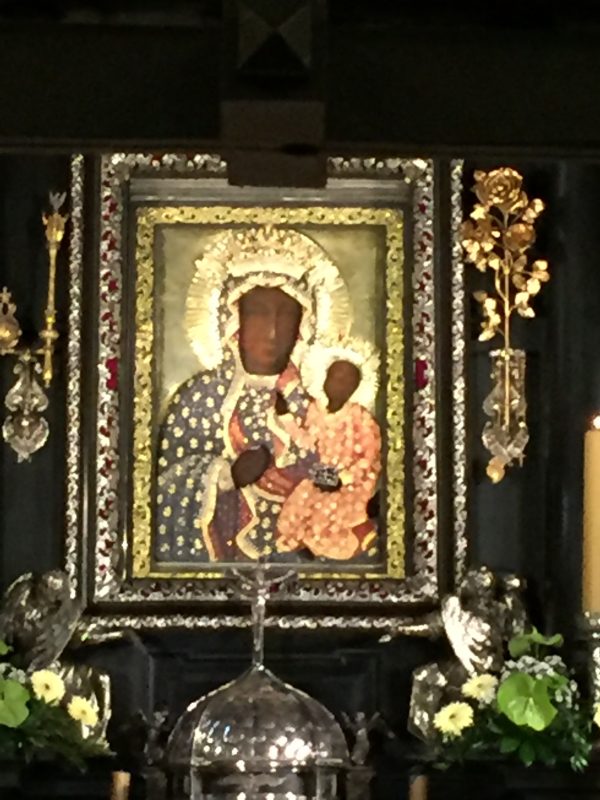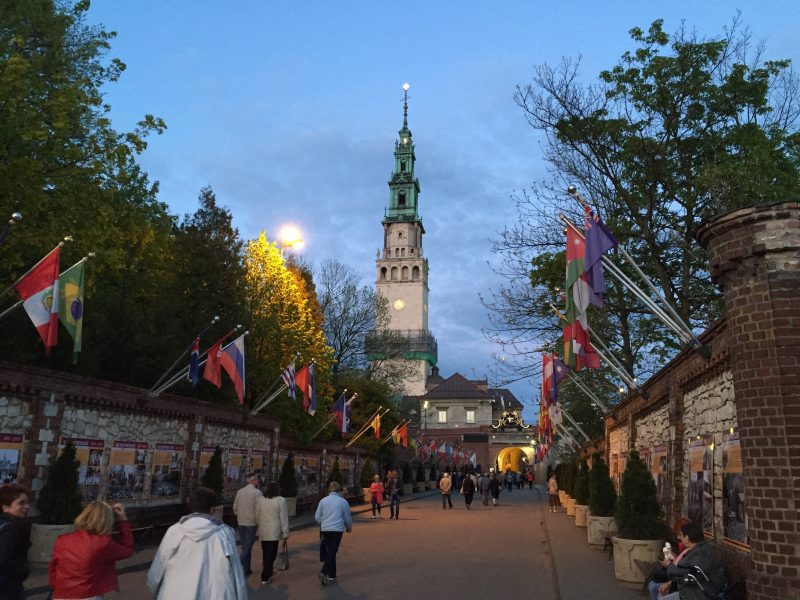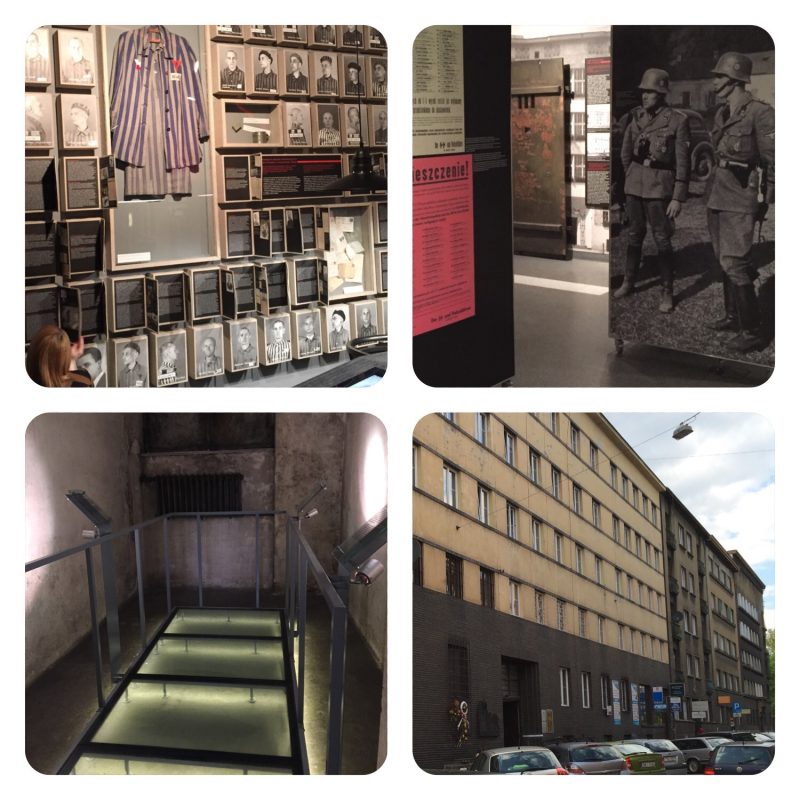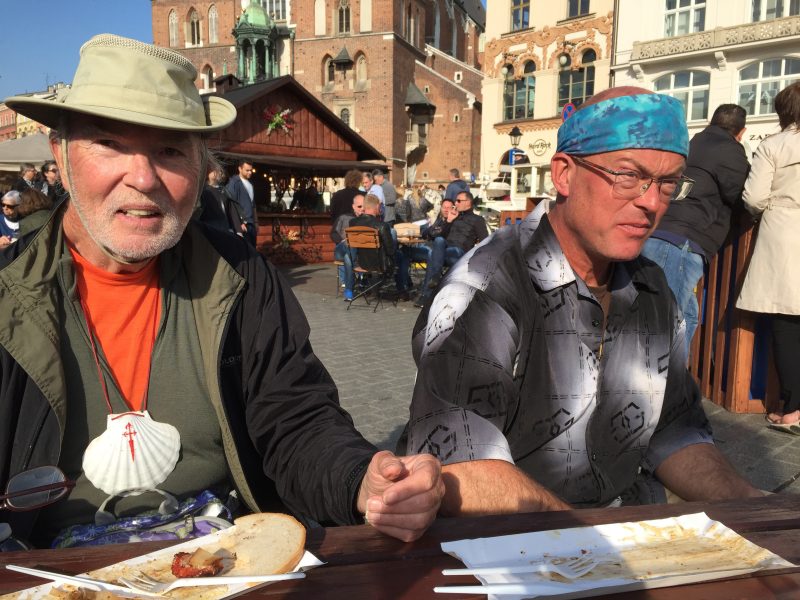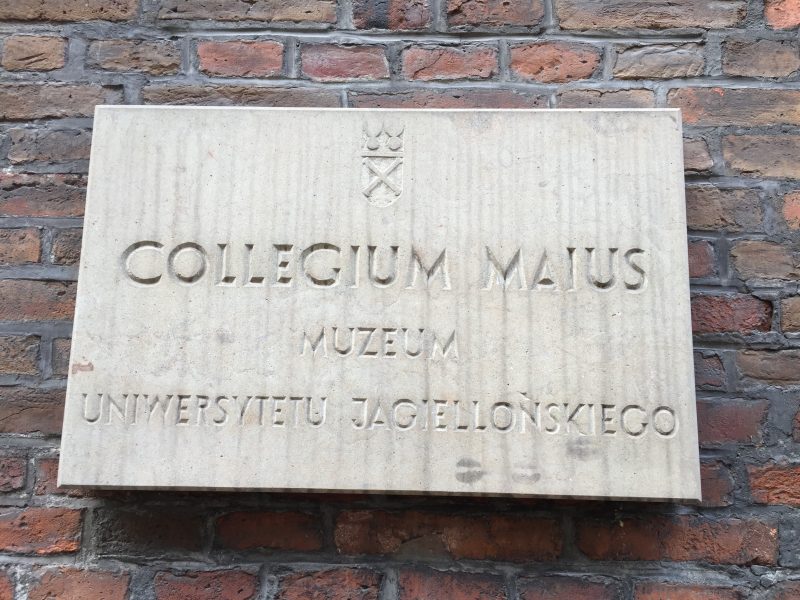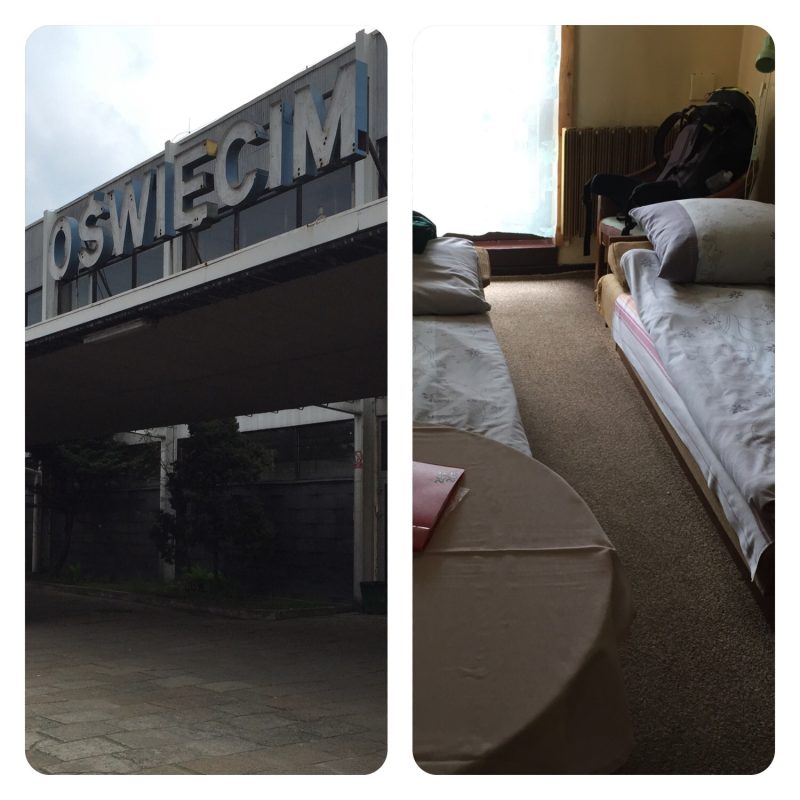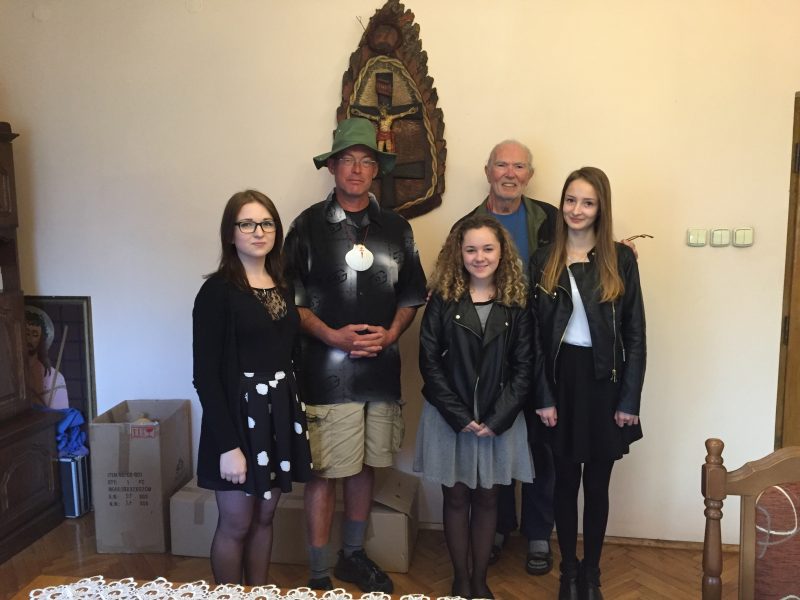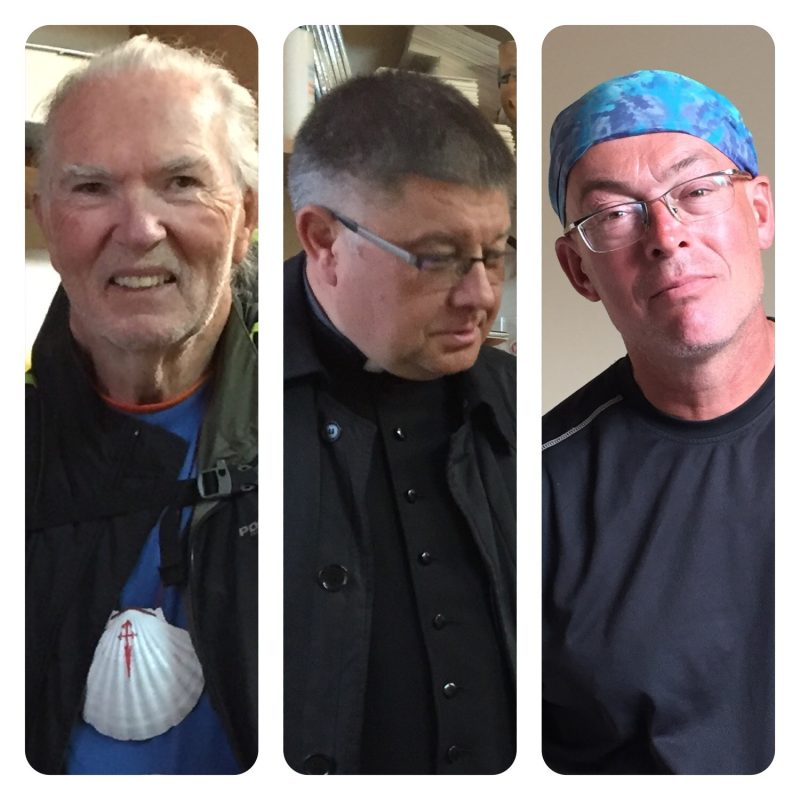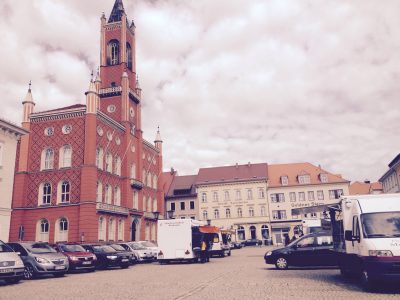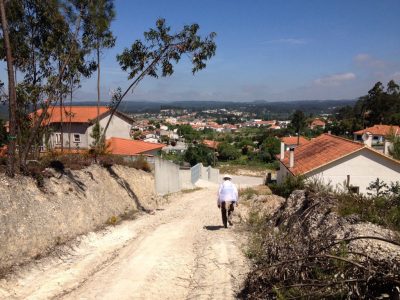Day 30 - Legnickie Pole to Jawor then by train to Swidnica
DAY 30 — Saturday, May 21, 2016
We left the Camino Trail heading south to Eddie's home town of Swidnica. Due to available south-bound train connections, we walked south off the trail from Legnickie Pole about 13 km to the town of Jawor. But another reason for Jawor was its unique post-30-years-war church made just of wood, clay, and straw!
The treaty of Westphalia of 1648 (after the 30-years war) permitted the Lutherans in the Roman Catholic parts of Silesia to build three churches from wood, loam and straw outside the city walls, without steeples and church bells. The construction time was limited to one year! Amazing piece of work. The second church under this treaty, we'll visit tomorrow here in Swidnica. I've included a set of pics.
Since 2001, these two remaining churches are listed as UNESCO World Heritage Sites.
Day 29 - Sroda Slaska to Legnickie Pole
DAY 29 — Friday, May 20, 2016
We trekked for 29 km (18 mi) and we both feel it--hence a short blog. Little intermittent cell service in this village of 900+. Pilgrim-priced lodging ($6.50/person) and food store for dinner--great picnic stuff (big jar rolled marinated herrings, bread, Edam cheese, fresh tomatoes, cold beer---WOW). Life is good.
Couple of pics show the trail. At one point we ran out of trail, finding a dead end at a waste-high rapeseed field. We fought on through waste-high grain and weeds grabbing at my sandals to make me fall--what to do??? We persevered but slowed our pace to a crawl. Then PocketEarth showed a nearby trail that rescued us (mind you, all maps were loaded onto the iPhone back home in California--no cell service needed!). The last pic shows us on an overpass over the A4, an "interstate" traversing Central Europe.
Day 28 - Sobotka to Wroclaw (by bus) then to Miekinia (by train) then on trail to Sroda Slaska
DAY 28 — Thursday, May 19, 2016
We followed Jakob's advice on today's routing--our friend of the Camino who lives in Sobotka. It worked out well to get in a 15 km walk through dense fields that ended abruptly in impassably high grain (one pic captures that).
Środa Śląska is a town of about 9,000 in lower Slesien, that belonged to Germany up to 1945, then transferred to Poland and ethnically cleansed of Germans as per the Potsdam Agreement. We marveled at the bell tower of St. Andrew's Church. Incidentally, nowhere else have I seen such majestic structures built with bricks than here in Poland! At St. Andrew's we also noted the Camino mileage marker--that was a motivator! Only 84 mi. to the German border.
Day 27 - Sabotka and day trip to Wroclaw
DAY 27 — Wednesday, May 18, 2016
First some logistics to move from a hotel to pilgrims quarters not far away. While waiting for the bus, we visited the local museum that immersed is in local discoveries of pre-homo sapient tools/bones (100,000 to 60,000 years ago). Then off by bus to Wroclaw for a fantastic sightseeing adventure. We took a 90-minute "golf cart" tour that covered every nook and cranny of the old town: won't bore you with dozens of pics, only one of the old city hall. We decided to go back afterwards to the national museum--what a gem of medieval art. We only include four unique pieces: a statue of the holy trinity (God the father is rarely depicted); a pieta painting; one of numerous triptychs, each more stirring than the last; and finally, a painting that gave us pause--pilgrims attacked by the local crowds, a practice quite common in centuries gone by.
After returning to Sabotka, we called a "friend of the Camino" whom we met earlier in the morning. He met us at a local restaurant and enriched our experience! The connection of Sabotka to the Camino (recall that we're 50 some km off the trail) is that early pilgrims used Mount Sleza as a waymarker--a prominent landmark that could be seen miles away. Consequently it became a part of the Camino network with a local St James Church and St James statues (see pic where we're standing under the main gate into the medieval city of Sabotka.
Day 26 - Brzeg to Olesnica Mala (then bus to Wroclava and off course to Sobotka)
DAY 26 — Tuesday, May 17, 2016
Today we made it up as we went along. After walking only about 15 km (9mi), we didn't see any places to stay overnight and a contact to call fell through, so we caught three buses in all deciding to get to Wroclaw (40 km) and beyond (off course) to Sabotka, another 36 km (22 mi) to the southwest.
Sabotka lies on the northern slope of Mount Sleza. Sabotka is on a Polish Camino, one of several that funnel into one in western Poland. Mount Sleza was the site of a sanctuary of the Celtic Boii (a Gallic tribe of the Iron Age) and gives its name to Silesia. I found it interesting that Mount Sleza in ancient times was the pagan Solar cult center. The area was Christianized in the 10th Century.
We'll visit the Church of St James (1738) tomorrow, one of the main draws for us. Pics for today include a glimpse of the roads, an impromptu lunch in the forest, and a distant shot of Mount Sleza.
Day 25 - Kolonia Popielowska to Brzeg
DAY 25 — Monday, May 16, 2016
We left our hunting lodge at around 8 am, and started on the Camino trail expecting about 27 km (17 mi). About two hours into it we found ourselves walking on a levee in tall, wet grass. Our socks were drenched and to top it off, we went in the wrong direction for about a mile! Enough of that! We stopped in the next village, after making up the error, changed socks, and decided to take the highway. The narrow shoulders made it nerve-wracking--never again--we'll take the wet socks (I have waterproof ones if I get advance warning!).
No pictures--too dangerous from the shoulders. And our $10/person place is still in the suburbs.
Day 24 - Opole to Kolonia Popielowska
DAY 24 — Sunday, May 15, 2016
We left Opole in the sunshine, but with a chilling wind that made it seem in the 30s--nearly all day. The total for the day was a bit less than the 30 km (18 mi) because our Camino host (and also a guide), Helmut had us stay on paved roads to avoid construction and mud on the trail. He met us about half way into the walk at a precious Salesian restaurant. The owner spoke German and we wasted no time getting a good beer and German food.
Helmut walked the next 15 km with us showing interesting sites. The first was St Rochus church--his statue hints at pilgrims (the walking stick, the shells). Then he showed us a special spring on the trail with healing powers. It was time to take a rest--and what better place.
Then we finished our second half at a hunting lodge--not quite as rustic as I expected. We each have our own room. Helmut's father-in-law came to bring food for the morning, to pick Hrlmut up, and a photo session (we're undoubtedly the first Americans to stay here).
Day 23 - Opole-Paczkow and back
DAY 23 — Saturday, May 14, 2016
Caught a bus at around 9 am for a 2-hr ride southwest to the medieval town of Paczkow. We began exploring by walking around the old wall then visited a few spots: the small plaza with old city hall, on the left, and the church dating back to 1300s. The church on the right in the duo, in fact, was used as as a fortification having a spring as water source inside.
When we arrived back in Opole, we focused on its Cathedral and its inside (one duo) and beautiful painting of the Madonna (standalone pic) renown for its having been the source of miracles. We always strive to get our credentials stamped--not always easy!
Then we walked back to the main plaza with its city hall, across which stand a row of very old, similarly styled houses.
Day 22 - Kamien Slaski to Opole
DAY 22 — Friday, May 13, 2016
After a self-serve breakfast, we headed out to Opole, a city of over 125,000 and once the capital of Upper Silesia, itself having a colorful history spanning over 1000 years. Silesia, since medieval times, has changed hands countless times and has been fractured with pieces belonging to Moravia, Bohemia, the Austrian Hapsburg Empire, Prussia, German Empire, Weimar Republic, Nazi Germany, Germany and Poland--it's enough to make your head spin.
Along the way, an Opole TV Crew caught up with us for an interview. I caught them in a few pics, too. The waymarkers also began to have an international flavor. As we neared Opole, we walked along the north/northwest flowing Oder River. It, in fact, becomes the border between Poland and Germany for quite a stretch. We landed a small but adequate room at a Jesuit educational facility on a "donativo" basis. We'll stay two nights to do an excursion tomorrow to the medieval town of Paczków, also called "Polish Carcassonne" or "Silesian Carcassonne" thanks to its well-preserved medieval fortifications (I've seen Carcassonne in France and am ready for a real treat).
The modern statue I've included honors the warriors who fought for the independence of Upper Silesia. It was so imposing and beckoned me to capture its image!
Day 21 - Toszek to Kamien Slaski
DAY 21 — Thursday, May 12, 2016
A wonderful day and one hard to bid farewell to such lovely hosts. We ended the evening before with my first drink of vodka in Poland--and a Finnish vodka at that--they know how to discriminate, and then a superb fresh-mint tea.
This day started with a hearty breakfast and then a departure to Mount St. Anne, a very popular Carholic Pilgrimage Site here in Poland. At 36 km. (23 mi.) from their house, it bumped us along our trail by two days, and helped build more slack time into a tight schedule. The mount of St. Anne, where a pagan shrine already stood during pre-Christian times, has a most unique geology: it's a monadnock, an isolated small mountain that rises abruptly from a gently sloping or virtually level surrounding plain. This Upper Salesian area is also strategic to both Germany and Poland and both languages are visible everywhere.
We admired the site, obtained the stamp for our pilgrims' credentials, and marched on to Kamień Śląski. Here we encountered a popular, nicely appointed Sanatorium at $15 per person incl. breakfast (and they spoke German). A hundred meters before this health spa, we soaked our feet in a cool wading pool just made for pilgrims (even if we did only walk 15 km/9 mi).
Tomorrow we expect rain and the next two days as well--but it's fun to walk in the rain as well: pura vida!
Day 20 - Zbroslavice to Toszek
DAY 20 — Wednesday, May 11, 2016
An exciting day! But the first pic I must show is a picture of the gifts the Camino folks gave us--truly from the heart--thank you! The socks with the arrow--how can you go wrong.
Eddie woke up feeling lousy with nasal and sinus drip and congestion, and felt like taking a day of rest, then changed his mind and decided to go for the 17 km. (11 mi.).
A short way into the walk while accompanied by rapeseed fields on our sides, the TV crew rang us trying to set up a meeting place for a shoot. We finally made it work after at least a half dozen calls. At Lubie, we met them and were involved with the crew for over an hour and a half--interviews in English and Polish--wow!
Then a wile later, a friend of the Camino (my term), picked us up and saved Eddie the last 5 km of walking. He took us to the castle in Toczek. The town dates back to the 9th/10th century and the castle to 1246. One can just imagine the long winding history.
To top off the day we were invited to stay for the night. Our hostess is not only literally the architect of the house but a great cook besides--the gowabki (spelled golabki) were fantastic.
Day 19 - Saczow to Piekary Slaskie to Zbroslavice
DAY 19 — Tuesday, May 10, 2016
Anticipated 30 km today (19 mi), but got a ride from Piotr from the regional Camino Club (the Polish APOC) who shortened our trek by 6 km (4 mi). Aside from great walking through forests, today seemed to be all about pilgrimage organizations.
In Piekary Slaski, we encountered the Polish Pilgrimage Center (not just Camino pilgrims). They had lots of information about the many trails to Polish shrines. We received a stamp in our credentials for visiting the adjoining minor basilica St Mary and St Bartholomew.
Then, as we approached our destination, we called Piotr of the Camino Club. He graciously picked us up, stopped at a point on the road where he painted Camino mirals, and then brought us to the Inn which also appears to be a riding stable and have a great restaurant. There we met a local group of Camino folks who had been on various Caminos, and the Camino discussion ensued. The pics tell it all.
Day 18 - Bedzin to Saczow
DAY 18 — Monday, May 9, 2016
An amazing day where two trail angels unexpectedly showed us the way to an enriched experience. The first met us at St. Doroty Chapel in the woods near the village of Grodziec. The church was erected in the first half of the 17th century and from its seemingly isolated location the Angel walked with us for nearly 2 km. to the parish church of Grodziec where several priests met us "with open arms" stamping our credentials, loading us with Polish Camino information and serving us coffee and cake. The first pic doesn't show the sincere hospitality they offered us. We were the first American pilgrims they had ever seen.
We left blessed by these priests and feeling we were again part of the "network." A bit down the road, we rested at a church in Rogoznik, where the second trail angel (who had walked the Polish Camino last year) took us under his wing by bringing us to his house, feeding us, loading us with information, and then--you won't believe this--walking with us for 10 km to Saczow where he had called ahead give notice that we were coming.
At Saczow, the priest offered us the most authentic pilgrims' quarters imaginable: one bed, one cot, no electricity or running water, but cute as can be. Before mass, they fed us and after mass, he offered us showers at the rectory. We were also interviewed by local news along with a photography session, etc.
It was an unbelievable day. Pics try to convey the atmosphere. The one altar is the St. James altar here at the church.
Day 17 - Czestochowka to Dąbrowa Górnicza (Back on Via Regia Proper)
DAY 17 — Sunday, May 8, 2016
Not much luck getting close to the Black Madonna last night with throngs of worshippers. BTW, the monastery where she's hosted dates back to 1382 (established by Pauline Monks from Hungary). This morning, although Sunday--and Mother's Day at that, was vastly different. She was majestic as she drew you into her influence. Czestochowka impressed me with the deep religiosity of Poland's people--those I saw and those I heard about.
Now heading south by train to link back up to the Via Regia proper. Before leaving we stopped at The 17th-century St Barbara’s Church just 1km south of the monastery. Its location is believed to have been determined by the spring that emerged here when the Black Madonna needed to be washed after it was vandalised (it’s still bubbling away behind the church)--and, yes, we filled up our water bottles.
Then just minutes from the train station, we met an 85-year-old Lieutenant Colonel in the Polish Army, about to celebrate a WW II event. I shook his hand and thanked him for his service (through Eddie). He smiled when told I had also served in the US Army at that rank.
Day 16 - Kraków to Auschwitz then to Czestowka
DAY 16 — Saturday, May 7, 2016
Left hostel at 6 AM and rolling on the bus by 6:30 to arrive at the Nazi's largest concentration and death camp within minutes after opening. We feared difficulty getting in without being part of a tour group, but within minutes we were part of the crowd.
Only one word comes to mind of the entire Auschwitz experience: gripping! No need to blog gruesome pictures of the details of the Camp's atrocities. One pic will do, namely the illusion at the camp's entrance for new victims: "Arbeit macht frei" (work brings freedom). The numbers of lives lost in the holocaust are staggering, especially here in Poland which had nearly 3.5 million Jews before the war (the largest Jewish Community in the world) and only 300,000 survived after the war. 1.1 million from all over Europe were dispatched to Auschwitz of whom 90% perished. Gripping!
Afterwards, we headed north of our Via Regia by bus to Czestowka, Poland's major pilgrimage center as well as its Catholic Center whose monastery houses its famous Black Madonna. This is a site not to be missed by pilgrims! Tried to see her tonight, but couldn't get close enough. Thousands were chanting and praying to her. Have a look at a picture of the Jasna Gora Monastery, a very large complex.
Day 15 - Krakow
DAY 15 — Friday, May 6, 2016
Today's highlight: a tour to the Wieliczka Salt Mine, located in the town of Wieliczka still within the Kraków metropolitan area. Two nights ago we actually stayed within a mile of the mine, but I wasn't yet in a sightseeing mode then and decided to skip it. Well, since then, I've learned to appreciate the magnitude of its importance. Thousands of visitors and hundreds of buses at the mine every day. It's a national treasure, not to mention still actively producing salt with 500 miners. Of dozens of pictures taken of this 700-year-old mine, we include only a few of the underground chapel with da Vinci's "Last Supper" carved in salt, and a mosaic showing a large cavern, carved statues, and mock-ups of horses used for lifting power--an amazing visit.
Then came a stroke of serendipity in that we noticed a sign at the lobby of our "Freedom Hostel" here in Krakow pointing to a museum at the basement level. It turned out to be a former Gestapo holding and execution venue that had since been turned into a museum--the mosaic captures the grim reality of Nazi activities within days of occupying Krakow on Sep 6, 1939. Tomorrow's visit to Auschwitz will amplify what we saw here by orders of magnitude!
Day 14 - Oswiecim (Auschwitz) back to Krakow
DAY 14 — Thursday, May 5, 2016
We showed up at the Auschwitz Concentration Camp only to discover it was closed because of a Survivors Parade. To them I would defer a visit any day; we'll try again on the 7th (Saturday).
We traveled back to Krakow, found a "Pilgrims' Price" hostel very close to the center ($15 per person per night!) and reserved it for two nights, and took a 2-hr "free" walking tour of the old Krakow City. Also made reservations for a pickup for the Salt Mines tomorrow at 9 am to go to Wieliczka (a short bus drive away).
We won't bore you with dozens of beautiful pictures of this impressive city except for two venues: (1) the Residence that St. John Paul II used when he came back to Krakow as well as the basilica where he would pray (he was archbishop of Krakow 64-78) and (2) the The Jagiellonian University founded in 1364 by Casimir III the Great in Kraków--it's the oldest university in Poland, the second oldest university in Central Europe and one of the oldest universities in the world. And, its two most notable alumni are Copernicus and St John Paul II.
I had to include two pics of Eddie and me on the largest medieval market square (200 m. x 200 m.) standing by a row of carriages waiting to take tourists through the city and a second of us enjoying kebabs on the square with throngs of others.
Day 13 - Wieliczka to Krakow and on to Oswiecim (Auschwitz)
DAY 13 — Wednesday, May 4, 2016
A short 13 km (8 mi) walk had us experiencing the Krakow morning rush hour. The two inbound lanes were just inching along. We eventually crossed a bridge over the Vistula River, Poland's longest and arrived at the city center. The game plan was to head to Auschwitz (Oswiecim), with their intercity train. That would give us a chance to prioritize what to see on Krakow.
The walk to the train station took us by the Krakow Galeria, a gigantic mall bustling with people, eateries of all sorts (incl. all the usual American brands), and the train ticket office. The train ride lasted nearly two hours and when we arrived at Auschwitz we had a difficult time getting oriented--the downpour didn't help. It took a cabbie to find us a "pilgrim-priced" hotel across the river from the camp.
Day 12 - Targowisko to Wieliczka
DAY 12 — Tuesday, May 3, 2016
We left our backpacks at the lodging (Hotel Savana)--sounds fancy but was simple--and trekked two km to the site of the 9th century Chelmie Castle. Not much of the castle can be seen, but the early settlement became occupied by the Equestrian Order of the Holy Sepulchre. Early travelers on the Via Regia (Camino) were protected by this Order.
The Order's history through absorption by other orders (eg. the Knights Templars, Hospitallers, etc.) is so complex--I don't pretend to understand it, except to mention that an 80-year-old priest has taken on the task of keeping the history alive. We took his personal tour in "his" museum. And we touched a little part of that!
Today was also confirmation at the church there in Chelmie (note the hearts at bottom left of altar--one for each youngster being confirmed). We saw them arrive at church. The one pic shows their vestments (the boy lives in the house to his left--quite a mansion. The other pic shows the older girls helping the priest with confirmation. Note: everyone is super excited about the upcoming World Youth Day celebrated in Poland at multiple venues, even at this little village!!!!
Near the end of our walk we saw some spectacular motor bike stunts and then came one of the best goulashes I've ever had--the meat layered on top of two scrumptious potato pancakes. Again we're in a hotel; the pilgrims' hostel was closed and we couldn't raise anyone at the Franciscan-run college.
Day 11 - Brzesko to Targowisko
DAY 11 — Monday, May 2, 2016
Left our trail angel's house at crack of dawn with full stomachs, lunches, and a bag of food and drink--unbelievably hospitable. On entering Brzesko proper, we found St. James church along with mass celebrated at the newer church "next door"--their apses being orthogonal so that being in one felt also like being in the other church (see altars side by side).
One of the priests (with good English) served us coffee and cake, followed by another one asking us to write into their visitors' log (see pic).
The real walking began thereafter, 25 km (16 mi) in all, but for the first time some climbs that took us 500-600 ft up with great views of the surrounding hills. We're still pretty much in southeastern Poland and closing in on Krakow.
